
New Hannover
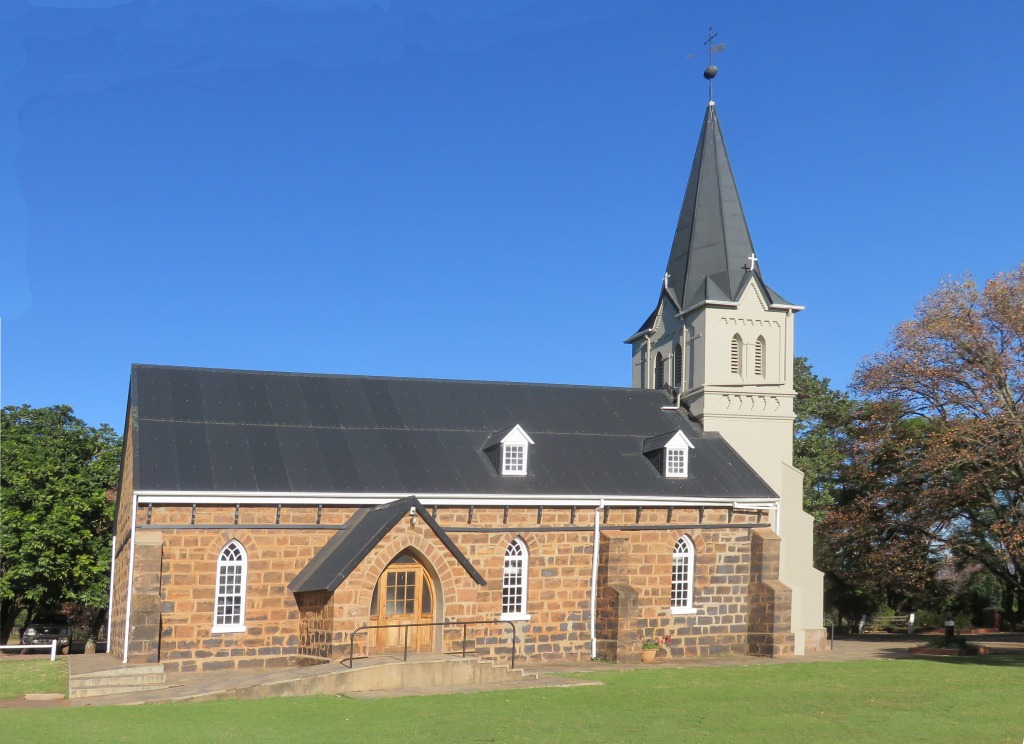 New Hannover, a small settlement in the central Natal region. The main attraction here is the German Lutheran church and the school. I didn't pay much attention to the town and only visited the school and church. This is actually where it all began. There was no town, just the church congregation to start off with. Change came when the rail reached the place in 1899. The station was about 3km away. A settlement started to develop around the rail station, which also meant that the general dealer near the church and school had to close.
New Hannover, a small settlement in the central Natal region. The main attraction here is the German Lutheran church and the school. I didn't pay much attention to the town and only visited the school and church. This is actually where it all began. There was no town, just the church congregation to start off with. Change came when the rail reached the place in 1899. The station was about 3km away. A settlement started to develop around the rail station, which also meant that the general dealer near the church and school had to close.
The geo position of the church is at 29.3572°S, 30.5583°E and 864m altitude.
History
The first German colonists that came to settle here were from the Jonas Bergtheil cotton growing scheme in New Germany. The background to this, Jonas Bergtheil came from Bavaria (Germany) in 1843 to Natal looking for business opportunities. He found it when he saw cotton being grown near Durban. He founded the Natal Cotton company and tried to attract colonists from Britain and Bavaria, when that failed he searched in the Kingdom of Hannover, which was part of Germany.Placing an advertisement he managed to attract 35 peasant families, a total of 188 persons. They arrived in Natal in 1848 and started farming near Pinetown, a place they called Neu Deutschland (New Germany). Cotton growing failed after two harvest that were plagued by boll worm. They turned to growing vegetables and cane. When their 5 year contract was up some of the families went to seek greener pastures further inland and came to the area of New Hannover.
The group in New Germany were all Lutherans and had their spiritual needs looked after by missionary Wilhelm Posselt from the Berlin Mission Society. When some of them moved to New Hannover they remained members of the congregation with Pastor Posselt visiting from time to time.
Farmers from Hermannsburg joined them and with time the numbers were strong enough to form a congregation of their own. This was 1858 and Pastor Schütze sent from Hermannsburg as their full time minister. But this was only for two years due to a conflict he had with the congregation. The conflict was about the admission of non-Lutherans to the congregation. A practise well established with Rev Posselt who felt he needed to serve the boer farmers as well. The problem, as seen by the Hermannsburg Mission, was that they were reformed Christians, but not Lutherans, rather Calvinists. The congregation felt that they wanted to swell their numbers and had no understanding of these differences in the religions.
the Church
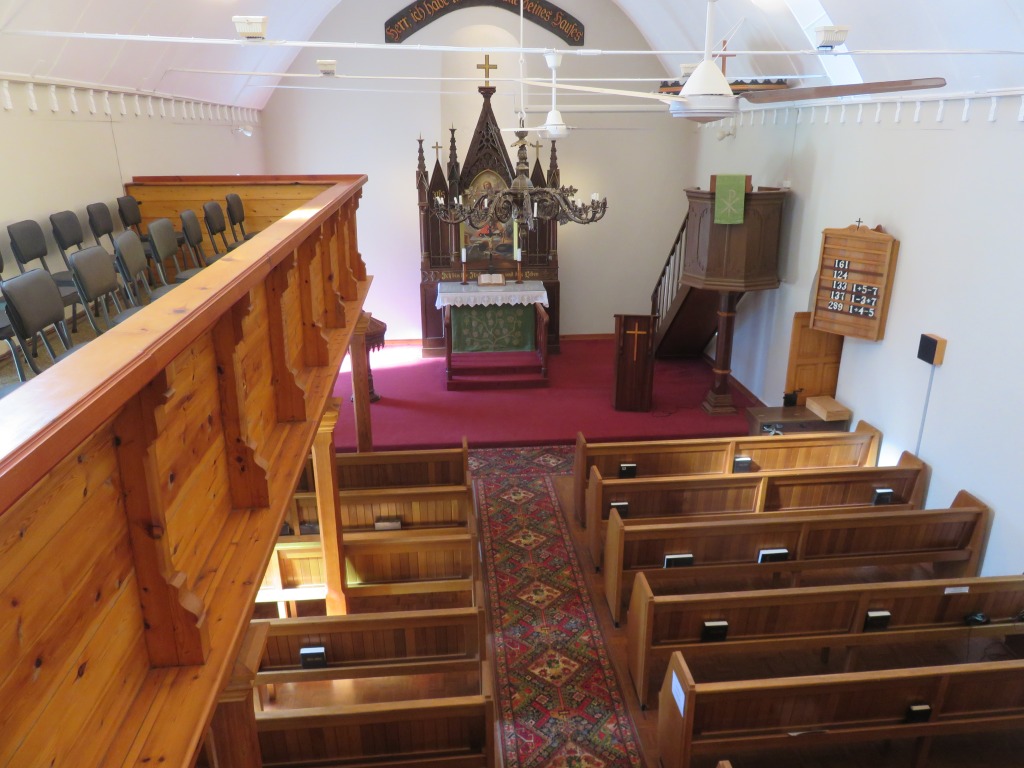 When Pastor Schütze first moved to the area he stayed in a structure made of wattle-and-daub on the farm of F.Aulfes. Wikipedia explains this as follows: 'Wattle and daub is a composite building material used for making walls, in which a woven lattice of wooden strips called wattle is daubed with a sticky material usually made of some combination of wet soil, clay, sand, animal dung and straw.' This structure served as church, school and minister's accommodation. A disadvantage of this arrangement was that to get to school many children had to cross the Injasuti river. The Boer farmer, Cornelius Laas donated 15 acres of his farm Mooiplaats for the erection of a church and school. This was the beginning of the present property. A two-roomed structure was built from unbaked mud bricks and thatch.
When Pastor Schütze first moved to the area he stayed in a structure made of wattle-and-daub on the farm of F.Aulfes. Wikipedia explains this as follows: 'Wattle and daub is a composite building material used for making walls, in which a woven lattice of wooden strips called wattle is daubed with a sticky material usually made of some combination of wet soil, clay, sand, animal dung and straw.' This structure served as church, school and minister's accommodation. A disadvantage of this arrangement was that to get to school many children had to cross the Injasuti river. The Boer farmer, Cornelius Laas donated 15 acres of his farm Mooiplaats for the erection of a church and school. This was the beginning of the present property. A two-roomed structure was built from unbaked mud bricks and thatch.
A solid church, made using sandstone blocks was erected and taken into use by Christmass 1867. The tower came later, it replaced a much smaller tower in 1885. The organ was supplied by the company W.Sauer Orgelbau Frankfurt (Oder) in 1904. The company still exists and did supply a new name plate only recently.
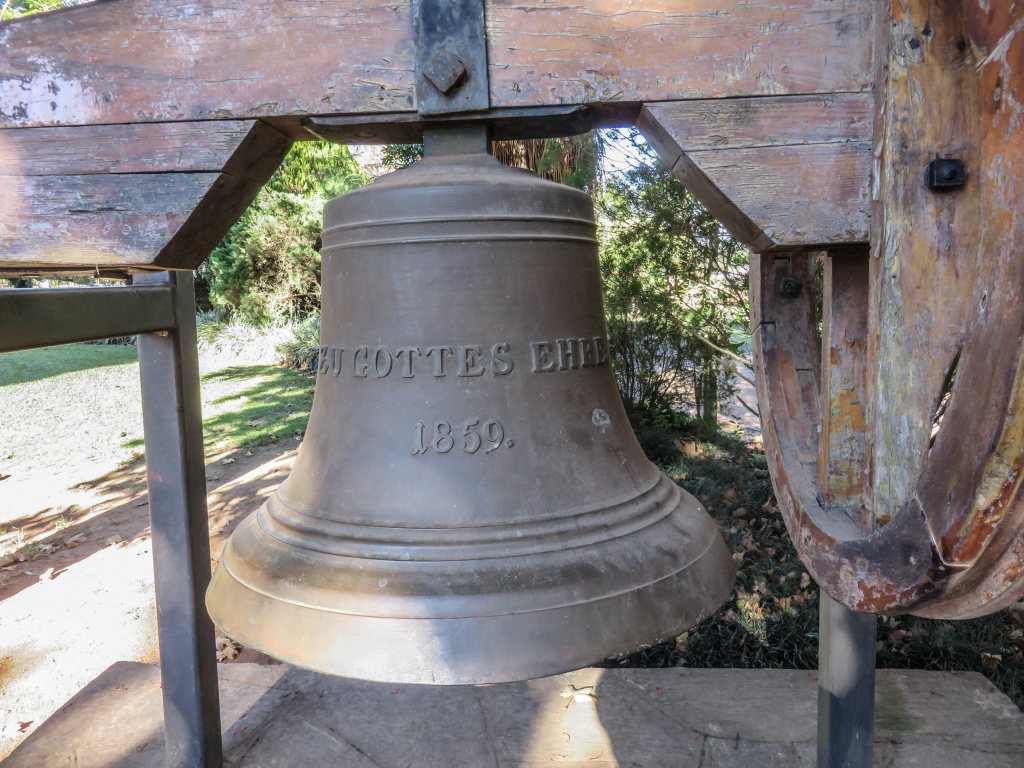 The original bell has its special place in the garden. It was cast in 1859, thus it must have done service for the older church already. It had to be replaced 1928, no information why, I presume what normally happens to pieces of cast iron with age is that they develop cracks.
The original bell has its special place in the garden. It was cast in 1859, thus it must have done service for the older church already. It had to be replaced 1928, no information why, I presume what normally happens to pieces of cast iron with age is that they develop cracks.
A major event during the history of the church was the tornado that hit the settlement on the 23 April 1948. It caused lots of damage, toppling trees, damaging buildings and took the roof off from the church.
A few words to the verse above the entrance: Bewahre deinen Fuß, wenn du zum Hause Gottes gehest, und komme, daß du hörest. It is part of a verse from the German Lutheran bible, the same verse in the New English translation (Ecclesiastes 5.1) is: Guard your steps when you go to the house of God. Go near to listen rather than to offer the sacrifice of fools, who do not know that they do wrong. The same verse, just a bit shortened, can also be found on the church in Braunschweig.
School
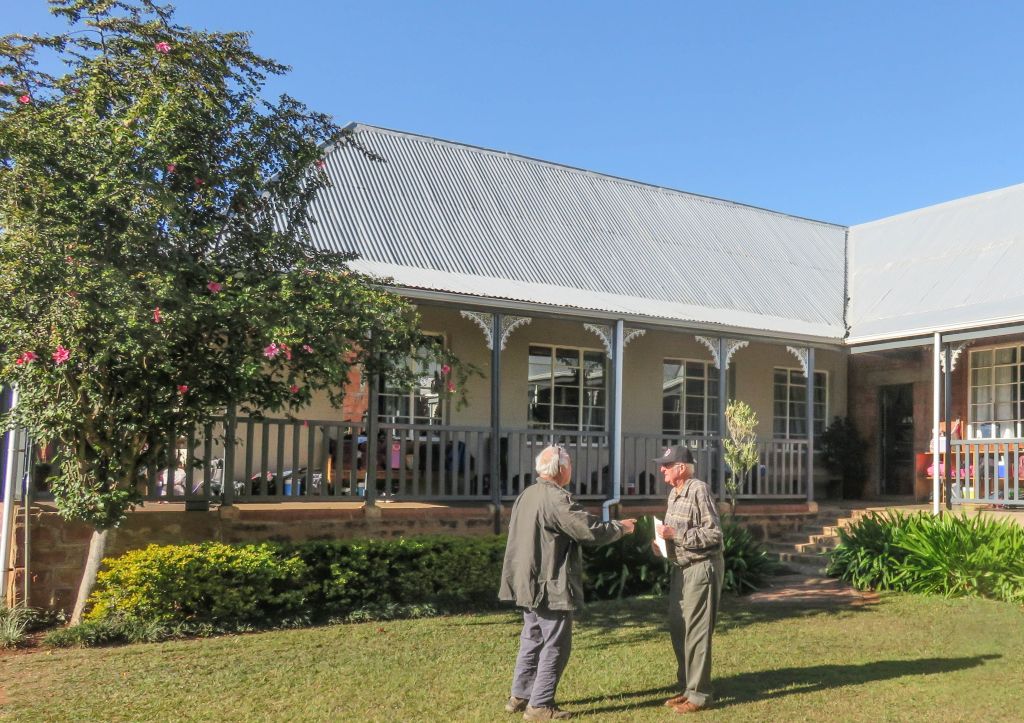 The school had its beginning on the farm of F.Aulfes, see above. Later the school and church moved over the river to a site donated by Cornelius Laas. That was a two roomed house made out of sun dried mud-bricks and straw roof. I am not sure what came after that, because numbers of scholars was increasing at a rapid rate and proper and more class rooms were needed. The picture shows the oldest wing of the school building. The person on the right is Hans Hillermann, a former pupil of the school
The school had its beginning on the farm of F.Aulfes, see above. Later the school and church moved over the river to a site donated by Cornelius Laas. That was a two roomed house made out of sun dried mud-bricks and straw roof. I am not sure what came after that, because numbers of scholars was increasing at a rapid rate and proper and more class rooms were needed. The picture shows the oldest wing of the school building. The person on the right is Hans Hillermann, a former pupil of the school
It looks like the medium of education was not German, even from the beginning. It was reported that not only the children of the German colonists went to that school, but also children from Boer and English colonists. Ref 2 reports that in 1910 a submission was made to the education authorities to allow a limited use of German as education medium. One can thus assume that before that the language was English. The submission, by the way, was successful.
The school now is a private school teaching from pre-school to grade 7, and its all in English.
Cemetery
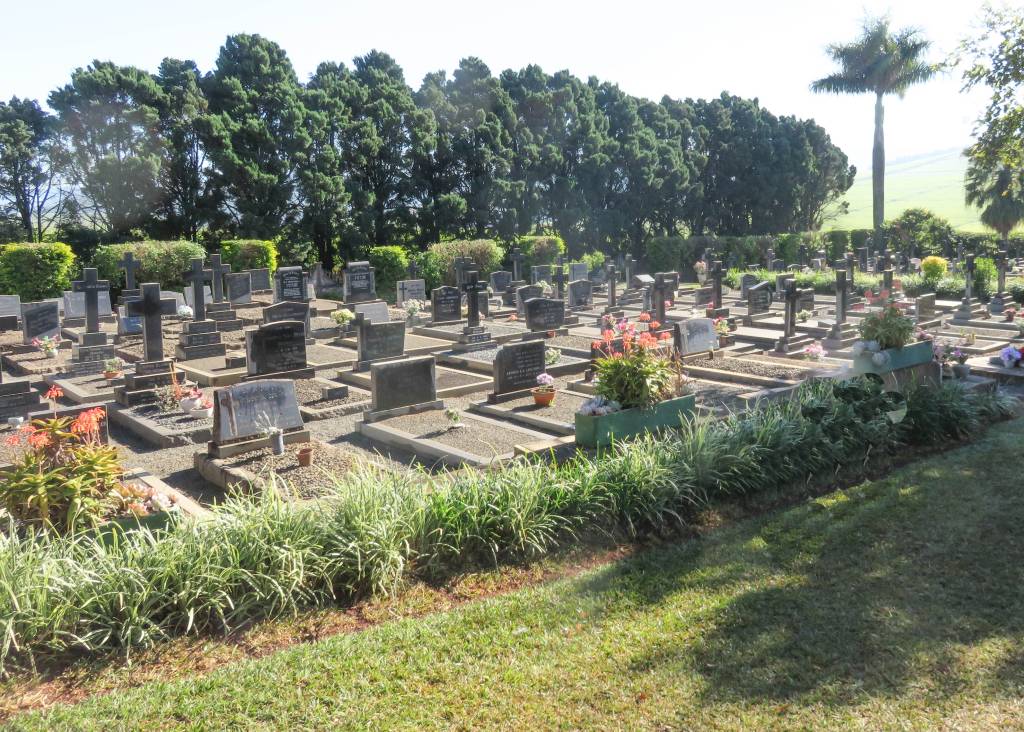
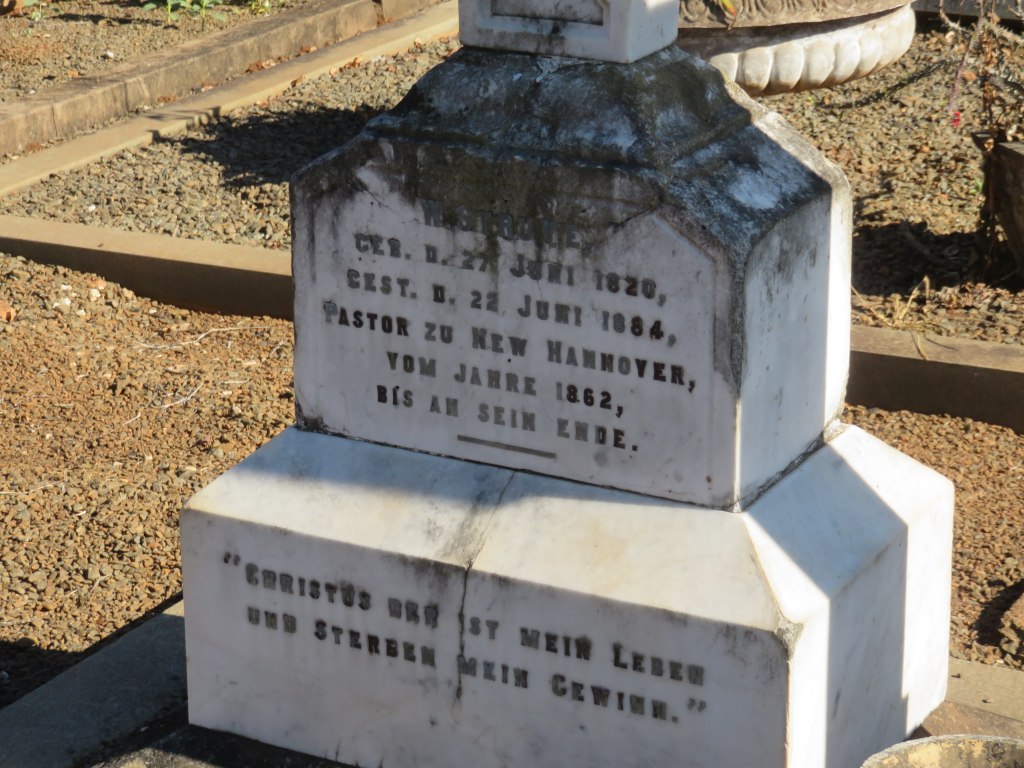 I picked out one of the graves, it's the one of W.Struve. He was the second full time minister of the congregation, serving from 1862 to the time of his death 1884. The grave stone is difficult to read, I could fix this with software, but it is easier to just write it out here: W Struve; Geb. d. 27 Juni 1820; Gest.d. 22 Juni 1884; Pastor zu New Hannover; vom Jahre 1862; bis an sein Ende. And at the bottom: "Christus der ist mein Leben; und sterben mein Gewinn".
I picked out one of the graves, it's the one of W.Struve. He was the second full time minister of the congregation, serving from 1862 to the time of his death 1884. The grave stone is difficult to read, I could fix this with software, but it is easier to just write it out here: W Struve; Geb. d. 27 Juni 1820; Gest.d. 22 Juni 1884; Pastor zu New Hannover; vom Jahre 1862; bis an sein Ende. And at the bottom: "Christus der ist mein Leben; und sterben mein Gewinn".
Pastor Wilhelm Struve was in the group of the first missionaries that arrived on board of the Kandaze in Durban 1854. He joined the Hermannsburg Mission Society receiving training from 1849 until his departure for Africa. He was in the group that initially sailed up the East Coast to take the mission work to Ethiopia, this failed because of the resistance from the Sultan who controlled the coast line.
Whilst at New Hannover his mission work concentrated on the farm labourers. Those labourers also included a small number of Hottentots that had come with the Afrikaner Boers during the trek into Natal. One of them, Joseph Gwamanda, attended the teacher's seminary at Ehlanzeni. He became an assistant to Pastor Struve and served him to the end. When Joseph died his last wish was to be buried at the feet of Pastor Struve, that was granted. Not knowing about this I didn't take a picture showing the grave.
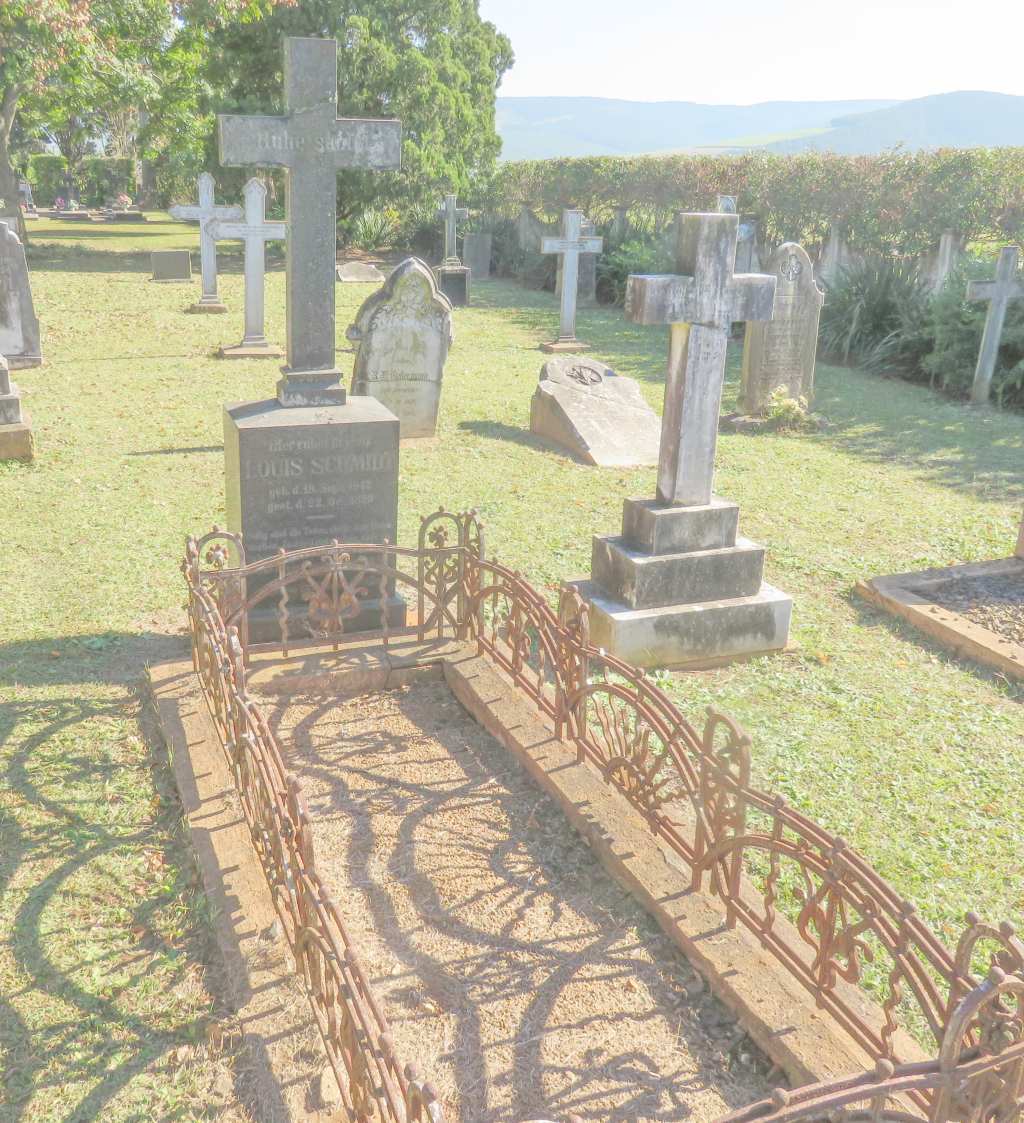 Another grave of interest is that of Louis Schmidt. He was the first head master of the school. Pastor Struve had his hands full with increasing numbers of students and it was decided to give some relief by appointing a full time teacher in 1877, that was Louis Schmidt. He had been a school master in Kroondal before this appointment. He later became head master of the school, and served in that capacity until his death in 1899.
Another grave of interest is that of Louis Schmidt. He was the first head master of the school. Pastor Struve had his hands full with increasing numbers of students and it was decided to give some relief by appointing a full time teacher in 1877, that was Louis Schmidt. He had been a school master in Kroondal before this appointment. He later became head master of the school, and served in that capacity until his death in 1899.
The grave stone reads: Hier ruhet in Gott; Louis Schmidt; geb.d.18.Sept 1842; gest.d. 22.Oct 1899
References
Ref 1.: Lutherans, Germans:Hermannsburgers, Natalia 22 (1992), H-J. Oschadleus (enter the title as a search term to find the article)
Ref 2.: New Hannover 150 years 1858-2008, a brochure issued by the Congregation Council of New Hannover